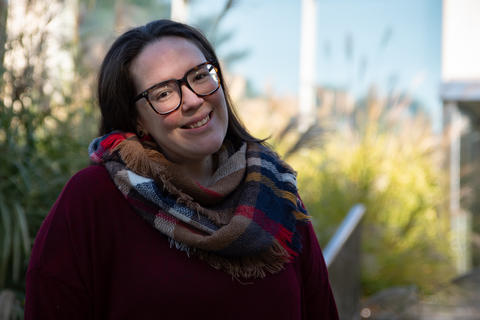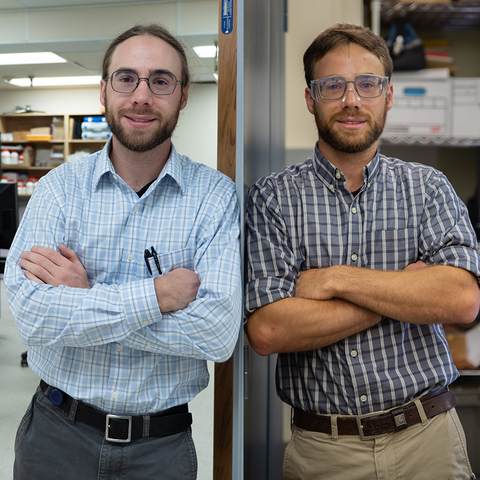Taking Measure
Just a Standard Blog
Hurricane Maria Recollections, Software Nostalgia, The Brothers Engineering: A Sample of Stories on NIST Social Media
The work happening at NIST can often be described as more than simply “work.” For social scientist Camila Young, it’s the opportunity to serve her home island. For staff who maintain the National Software Reference Library, it’s the (sometimes fun and unusual) role of protector for humanity’s digital history. Two of our mechanical engineers might even call it a family affair.
Catch up on a few of the happenings at NIST, as told during the past several months on social media.
Once Her Struggle, Now Her Strength: Camila Young Evaluates Shelters in the Wake of Hurricane Maria

Five years ago, Category 4 Hurricane Maria struck the island of Puerto Rico. Thousands of miles away, NIST social research scientist Camila Espina Young — a Ph.D. student at the time — could do little more than watch the disaster unfold on her home island.
The little that she could do still mattered. Located in a small community in New York with limited internet access, Camila turned on her computer, jumped onto social media and started amplifying any critical information for the public (shelter locations, news reports, etc.) that she could find. She was constantly refreshing her social media feeds to gather and share as much intel as possible.
But as the minutes and hours passed by, she started to see voices from the island turn silent. Cell service cut out in Puerto Rico. The only people online were family and friends of the Puerto Rican diáspora concerned about their loved ones.
That was an awful day.
Now at NIST, Camila works on a National Construction Safety Team investigation of how critical buildings performed during the storm, as well as how emergency communications systems worked.
Specifically, she uses her background as a journalist and expertise in disaster communications to evaluate storm shelter selection criteria and design requirements. Camila gathers data on the storm shelters selected for use during Hurricane Maria, as well as the way those selections were communicated to the public.
And amid the shelter lists and databases, her connection to the island shines through.
In her heart, Camila never strays too far, keeping one eye on the island and the other on her stateside life. As a native Spanish speaker from Puerto Rico, she adds an essential layer of context and background to the effort.
That means she can help keep our other researchers up to date on the news and events of Puerto Rico. She can parse complex Spanish-language documents (news reports, government documents, etc.) and quickly determine their relevance. And she helps to ensure the language we use to connect with the community in Puerto Rico accurately reflects the nuances of Spanish used on the island.
For Camila, the worst thing that ever happened became an opportunity in her professional life. Now, it’s a personal motivator.
Step Inside the National Software Reference Library

Apps, games, systems in multiple languages — more than one billion pieces of software rest in a closely monitored storage facility on the NIST campus in Gaithersburg, Maryland.
Today, we walk you through the National Software Reference Library (NSRL). More like an evidence locker than a storage closet, the NSRL is a critical resource for law enforcement, government and industry alike.
When criminal investigators seize a computer, they need to quickly push aside the information that doesn’t relate to a potential crime and get to the point. The NSRL helps by providing a digital fingerprint (aka “hash”) that identifies each piece of software. That way, the investigators can weed through the unnecessary data and reach the suspicious programs, such as multiple QuickBooks apps on a computer owned by a suspect accused of financial malfeasance.
Beyond criminal investigations, the NSRL can help organizations be rid of unwanted software across their computers.

When federal agencies were required to stop using Kaspersky cybersecurity products in 2019, IT specialists turned to the NSRL to get the software off all of their computers. When Napster reigned over the music industry and pop culture in the early 2000s, multiple companies used the NSRL to help wipe corporate computers after their employees plugged in their personal devices with the software.
The physical library has multiple rows of shelves that house some nostalgia-inducing contents, including The Sims Online, Warcraft II: Battle Chest, The Oregon Trail 5th Edition, Microsoft PowerPoint 2003 and After Dark (computer screensaver software displaying flying toasters, of all things).
Its digital counterpart, a server in another room, has many more exciting additions. Quarterly captures of messaging apps such as WhatsApp or Snapchat, more than 4,200 titles available via Steam, more than 200 titles of virtual reality software ... the list goes on and on.
As more apps push live and systems hit the market, our experts are ready to incorporate them into the library. Learn more about the NSRL.
Two Brothers, One Passion for Mechanical Engineering
This is a tale of two brothers who both found a passion for mechanical engineering research, separated to pursue their own interests in graduate school, and came together again at NIST (albeit at campuses in different states).
Twin NIST postdoctoral researchers Alexander Landauer (at right in photo below) and Orion Kafka grew up in rural Vermont, home-schooled by their parents — both educators — until the sixth grade. As they navigated coursework through middle and high school, both embraced a mindset for mechanics and hands-on activities.

Moving on to the same college for undergraduate studies, Clarkson University, Alex and Orion began pursuing research topics specific to their unique interests. In a summer research program, Alex turned toward orthopedic biomechanics — microscale bone material properties — while Orion ran experiments to study the fatigue of structural materials.
The different research interests became more pronounced when the two brothers interned at Oak Ridge National Laboratory. Alex studied the properties of oil additives at the nanoscale. Orion calculated ways to make harsh processes, such as smelting for glass, more energy efficient. The experience gave the two an appreciation for work happening at national laboratories.
This is where the two part ways in their story: Ph.D. studies. Alex attended Brown University to dive deeper into experiments with soft materials and cell biomechanics. Orion headed to Northwestern University in pursuit of experience with computation and materials science.
Eventually, their paths reconvened when they both applied to work as postdocs through the NRC Research Associateship Programs.
During his doctoral studies, Alex had explored materials associated with impact protection equipment (such as football helmets and soccer shin guards) and measurement techniques for the cell mechanics of traumatic brain injuries. At the time he earned his degree, in October 2019, NIST was wrapping up a collaborative challenge to explore materials for helmets that could better withstand impact and prevent those injuries. A principal investigator of NIST’s effort had an NRC opening, and Alex applied.
Orion found NIST in a wholly different way. At the start of his graduate studies, he was introduced to NIST through a joint center with his university called the Center for Hierarchical Materials Design (CHiMaD). Orion worked collaboratively with CHiMaD researchers, developing models to determine how strong new alloys needed to be for their intended functions (e.g., stents and heart valve frames). He saw a NIST call for postdocs in metal additive manufacturing and applied.
Alex ended up on NIST’s campus in Gaithersburg, Maryland; Orion settled into life on NIST’s campus in Boulder, Colorado.
Now, the two brothers have their own unique projects at NIST, but there are opportunities for collaboration across the distances. Alex has experience with imaging-based techniques in experiments, and Orion can bring data-driven modeling techniques to help.
So in this case, the family that researches together may produce great results together (such as this dataset). We’ll see what comes next!
To get news like this and other updates, follow NIST on social media:
- National Institute of Standards and Technology
- National Initiative for Cybersecurity Education
- Organization of Scientific Area Committees
- Communications Technology Laboratory
- Manufacturing USA group
- Manufacturing Extension Partnership
YouTube






This site is excellent and so is how the subject matter was explained. I also like some of the comments too.
Looking forward to your next post.